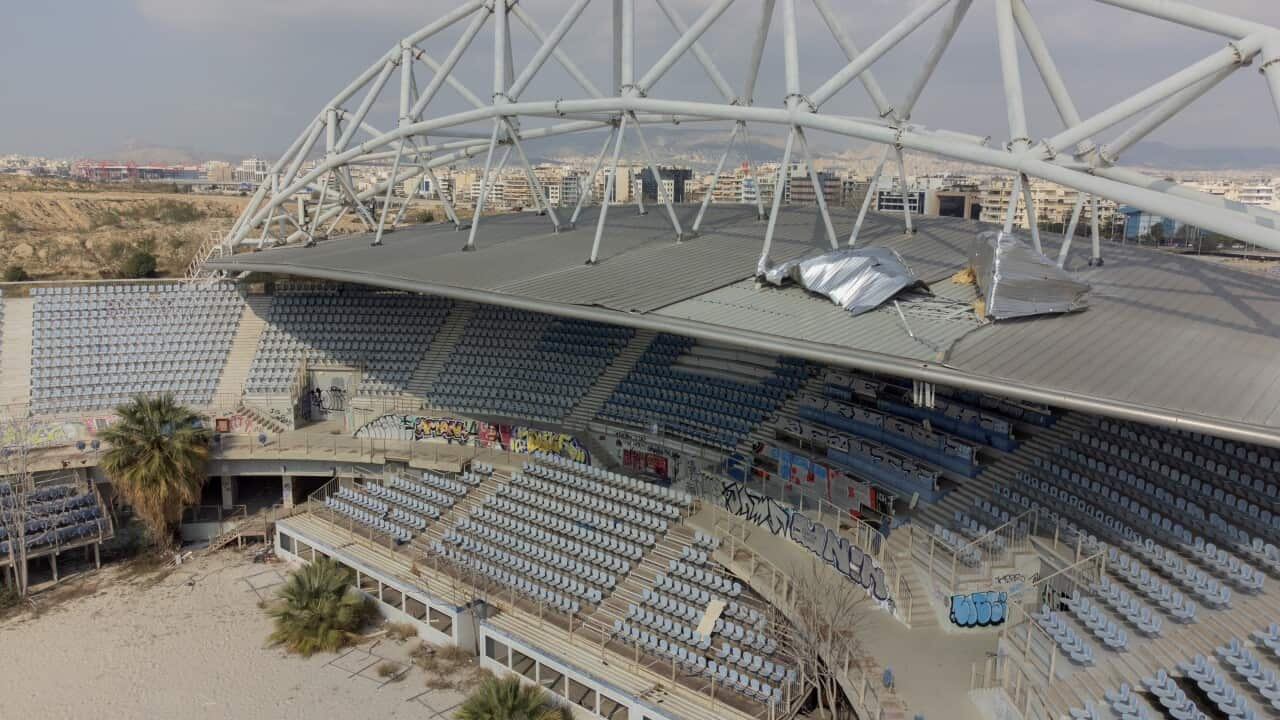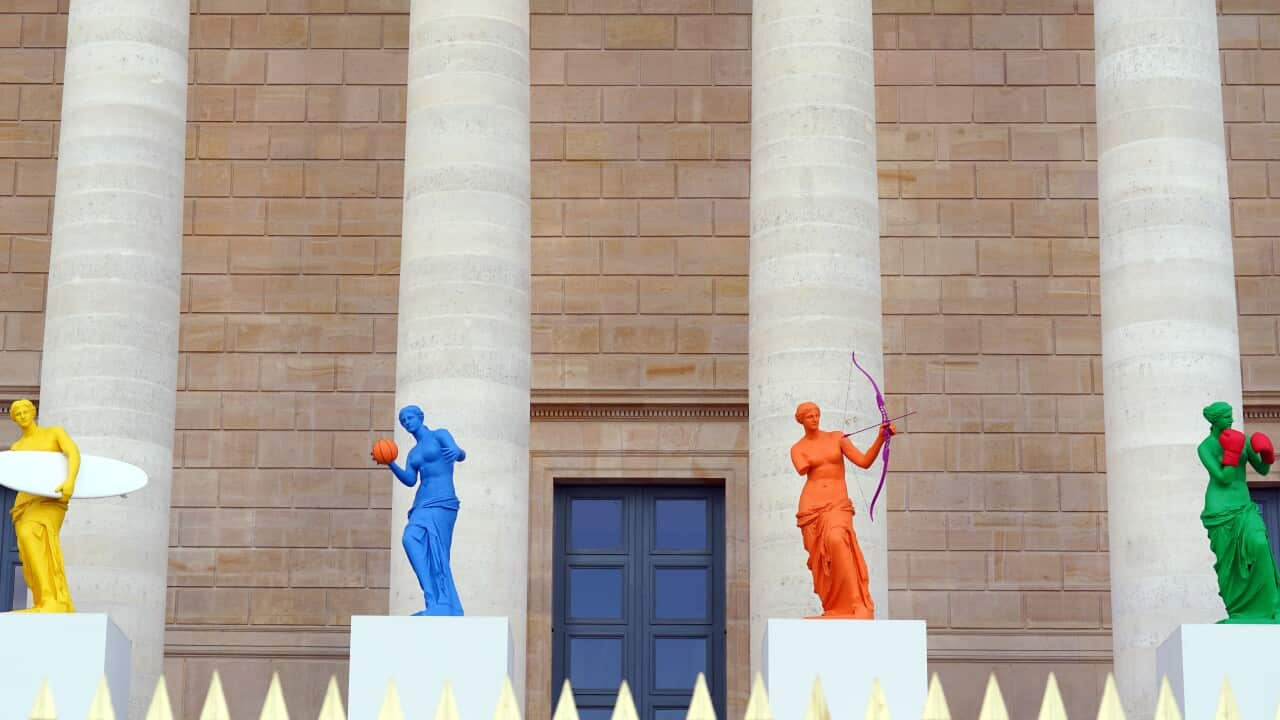Olympic Games are big affairs that require massive infrastructure projects to build the various stadiums and venues.
Many of the sports have specific requirements — fake white water and rocks for kayaking, huge slopes for ski jumps, or sand for beach volleyball. On top of that, these venues need to be able to support large crowds and the technology needed to manage the events.
As former Victorian premier Dan Andrews discovered in 2023, hosting big sporting events costs big money.
The Tokyo Olympics are estimated to have cost $23 billion, a lot of which was spent building infrastructure.
A 2022 report from the International Olympic Committee revealed that 85 per cent of the stadiums, venues and structures used in the Olympics are currently still in use.
But how are they used, were they new structures and what happened to the 15 per cent of venues that have fallen into disuse?
Stadiums
The all-marble Panathenaic Stadium hosted the first modern Olympics in Athens, Greece, in 1896.
It was used again during the 2004 Olympics (archery and the marathon finish) and is now a popular tourist attraction that has hosted events such as concerts and fashion shows in recent years.
Francis Olympic Field in St Louis in the United States was used as the main venue for the 1904 Summer Olympics. It is the oldest Olympic stadium still in regular use for official sporting events.
It has been renovated several times and is currently used by Washington University’s track and field, cross country, football, and soccer teams.
Many Olympic stadiums continue to be used for local, national and international sports such as athletics and soccer, as well as large concerts and performances.
For example, the 1960 Summer Olympic Stadium in Rome, Italy, is the home ground of the national rugby union team and soccer clubs Roma and Lazio. It has also hosted matches in the 1990 FIFA Soccer World Cup, UEFA Soccer Champions League, World Athletics Championships and more.
Fisht Stadium in Sochi, Russia, hosted the 2014 Winter Olympics and Paralympics. It also hosted games in the 2018 Soccer World Cup (including Australia vs Peru) and is now the home stadium for soccer team PFC Sochi.
Cities that have hosted multiple Olympics have refurbished and reused venues.
For example, Tokyo reused 1964 venues such as the Tokyo Metropolitan Gymnasium and Nippon Budokan Hall in 2021; the Los Angeles Memorial Coliseum and Rose Bowl were both Summer Olympic sites in 1932 and 1984 and will be used again in 2028.
Venues
Olympic venues continue to be used for sporting and non-sporting activities.
Many existing venues such as skiing slopes and summer venues such as Banyoles Lake (rowing — 1992 Barcelona Summer Olympics) and Wimbledon (tennis — 1908 and 2012 London Summer Olympics) hosted their sport before the Olympics and have continued to host it after the Olympics.
Other venues have been reused in a variety of ways.
For example, the stadium and skating and ice hockey venues used in the 1928 and 1948 Winter Olympics in St Moritz, Italy are now part of a private residence.
The 1980 Winter Olympic village in Lake Placid, US, is now a federal prison.
The Water Cube (swimming, diving, water polo – 2008 Beijing Summer Olympics) is now a popular water park.
Unused venues
Some Olympic venues such as the Mt Eniwa downhill events site (used for alpine skiing at the 1972 Sapporo Winter Olympics) and Copacabana beach volleyball arena (used for beach volleyball at the 2016 Rio Summer Olympics) were temporary venues that were dismantled after the games as planned.
Many other older venues have been renovated and redeveloped.
Other venues have unfortunately fallen into disrepair for various reasons.
The Trebevic Olympic Bobsleigh and Luge Track (bobsleigh, luge – 1984 Sarajevo Winter Olympics) was damaged during the Bosnian War (1992-1995) and has not been repaired. It is now overgrown and covered with graffiti.
Alonzo Herndon Stadium (hockey – 1996 Atlanta Summer Olympics) is in a similar graffiti-covered state of disrepair.
Most of the Helliniko Olympic Complex (softball, canoe/kayak, hockey, baseball, basketball – 2004 Athens Summer Olympics) is closed or has been demolished due to poor planning and political, economic and administrative upheaval.
Australia
So how have Australia's Olympic venues fared? In short, pretty well.
Most Melbourne 1956 Summer Olympic venues such as the Melbourne Cricket Ground (athletics, soccer, hockey, opening and closing ceremonies) and Exhibition Building (basketball, weightlifting, wrestling, modern pentathlon) are still used regularly.
Only the Melbourne Olympic Park Velodrome (cycling, currently a medical centre) and the Merritt Rifle Range (shooting, currently a housing estate) are not in use.
Venues built specifically for the Sydney 2000 Summer Olympics such as the Sydney International Aquatic Centre (swimming, diving, water polo) and Penrith Whitewater Stadium (canoeing, kayaking) continue to be some of the premier locations for their sports in Australia. The Olympic Village is now part of the suburb of Newington.
Some temporary venues such as the Bondi beach volleyball arena were dismantled after the games as planned. The Sydney Entertainment Centre (volleyball) is the only non-temporary venue no longer in use. It was demolished in 2016 as part of the redevelopment of Darling Harbour.
As we head towards the Brisbane Olympics in 2032, careful planning will be needed to ensure that planned infrastructure is cost-effective and can be used by local residents, and others, for many years after the games have finished.
Vaughan Cruickshank is a senior lecturer in health and physical education at the University of Tasmania.
Tom Hartley is a lecturer in health and physical education at the University of Tasmania.


